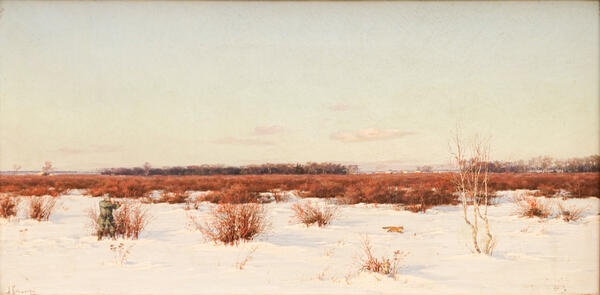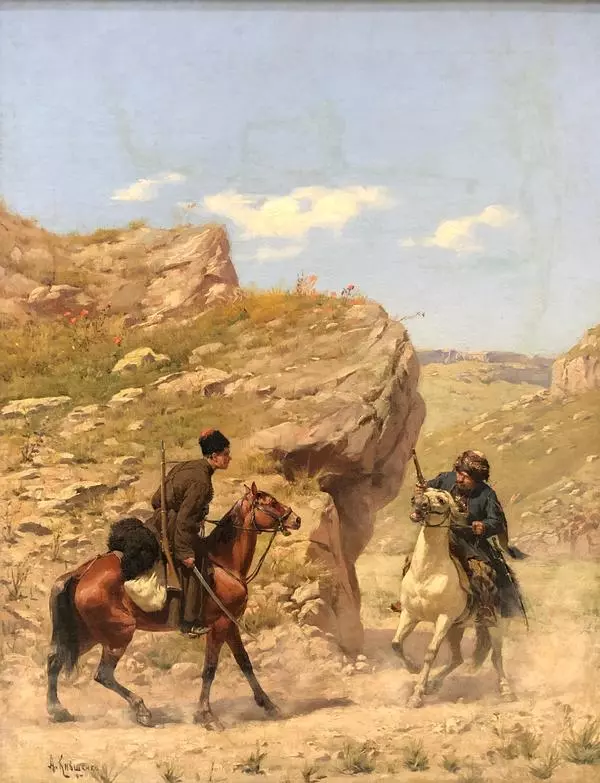The artist Alexey Danilovich Kivshenko was born on 22 March 1851 in the village of Serebryanye Prudy, Venev district, Tula Governorate. His father was a serf of Count Sheremetev. There were 12 children in the family. Since childhood Alexey was fond of drawing, enthusiastically copying battle and hunting scenes from magazines, and singing in the church choir. At the age of nine, the boy was sent to St Petersburg, where he enrolled in the choir chapel and the drawing school of the Society for the Encouragement of Arts, and attended the drawing evenings of Ivan Kramskoy. In 1867 he entered the Academy of Arts and the State Institute of Technology at the same time. He audited classes at the Medical-Surgical Academy for a year. Eventually his love for painting took the upper hand, and in 1870 Kivshenko was enrolled at the Academy, the class of historical painting. He studied with great zeal. The album of watercolors he created was acquired by the Academy. The medical knowledge received earlier came in handy when he was mastering anatomical drawing, and the atlas drawn by him served as an academic textbook for a long time. His graduation work “The Military Council at Fili” enabled the artist to continue his studies abroad and created a real sensation: his colleagues appreciated it highly and his contemporaries instantly bought up the painting’s reproductions. Kivshenko became known not only at home but also abroad. “The Military Council at Fili” is still considered to be one of Kivshenko’s most successful paintings.
While abroad, Alexey Danilovich perfected his skills for about four years, was very homesick and returned to Russia twice. Staying in the Voronezh Governorate, he became passionate about hunting and painted a number of pictures dedicated to the subject: “Hare Hunting”, “At the Kennel”, “Fox Hunting”, “Hunted”. The artist developed a love of hunting in his childhood years spent in the countryside. In his numerous and successful hunting pictures the memories of youth are revived with full force. Kivshenko was awarded the title of Academician. This was the first time in the history of Russian painting that such a high distinction was given solely for hunting pictures.
Emperor Alexander III was the main customer for Alexey Kivshenko’s canvases. He saw the true value of the painter’s talent. The tzar invited the artist to travel to Transcaucasia to collect material for paintings depicting the Russo-Turkish war. The Tsar’s commission was carried out: Alexey Danilovich visited Bulgaria and the important sites of bygone battles, including Shipka, Plevna and Gorny Dubnyak. The artist devoted his later years to teaching. He taught a class in battle-painting at his alma mater, passing on his invaluable skills to the new generation of artists.
While abroad, Alexey Danilovich perfected his skills for about four years, was very homesick and returned to Russia twice. Staying in the Voronezh Governorate, he became passionate about hunting and painted a number of pictures dedicated to the subject: “Hare Hunting”, “At the Kennel”, “Fox Hunting”, “Hunted”. The artist developed a love of hunting in his childhood years spent in the countryside. In his numerous and successful hunting pictures the memories of youth are revived with full force. Kivshenko was awarded the title of Academician. This was the first time in the history of Russian painting that such a high distinction was given solely for hunting pictures.
Emperor Alexander III was the main customer for Alexey Kivshenko’s canvases. He saw the true value of the painter’s talent. The tzar invited the artist to travel to Transcaucasia to collect material for paintings depicting the Russo-Turkish war. The Tsar’s commission was carried out: Alexey Danilovich visited Bulgaria and the important sites of bygone battles, including Shipka, Plevna and Gorny Dubnyak. The artist devoted his later years to teaching. He taught a class in battle-painting at his alma mater, passing on his invaluable skills to the new generation of artists.







